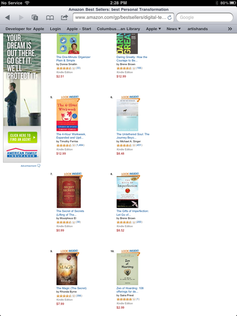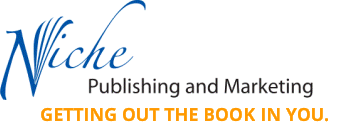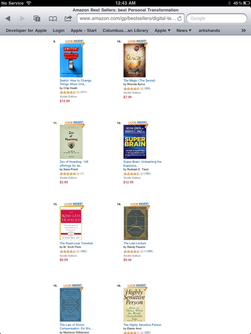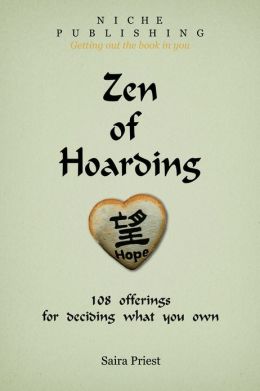
How would YOU like to announce one day that your book made the TOP 10 Bestseller in Amazon's rankings?
Imagine a headline like this:
Niche Publishing & Marketing's featured book, "Zen of Hoarding" by Saira Priest makes #10 on Amazon's Bestseller rankings in "Personal Transformation" ebooks.
Well, that is not imaginary, it is real. Niche Publishing did get it there, and the book shares rankings with heavily marketed books listed with bigger budget traditional publishers and top named authors with popular books (see pic left and below) like Deepak Chopra's "Super Brain," Marianne Williamson's "The Law of Divine Compensation" and Randy Pausch's "The Last Lecture"!! So how excited would you feel if you ranked with the "big dogs"? You are probably wondering: How did you do it? You are about to find out.
There are three factors that played into our success:
1. TIMING THE TOPIC
When it comes to non-fiction books, timeless and classic topics succeed; otherwise, the market must be ripe for the topic to have a chance at success. Ask, is this a hot topic? Are people talking about it? Are there TV shows on it? Does it show up on the news often? In our case, the topic is very alive in all these areas.
In our example, controlling clutter, organizing your home, addressing hoarding, and discovering a minimalist lifestyle are very relevant topics in people's lives today. Taking a Zen approach also touches on another hot topic of mindfulness. Not only that, but managing our things affects everyone in nearly all walks of life, therefore it is also a timeless topic.
2. BUILDING THE BUZZ
We used multiple online venues to promote the book. Niche Publishing's website only promotes one book at a time on our "latest book page" to draw all the attention on that book. Each book, of course, has its own webpage and, where possible, we use its book title as the URL to optimize being found on search engines. Each book gets its own Facebook page, Google+ page, references on several blog sites like Hubpages, Squidoo, Wordpress and several others, and a full-blown e-mail blitz and social media buzz to get the word out and keep it going in topic relevant email listings and sites.
and that brings us to the title of this article . . .
3. PRICING IT RIGHT . . .
There are many great write-ups on various strategies on pricing e-books. With the primary question being whether or not a FREE book campaign ultimately results in greater overall sales considering how many are given away. There is of course the known fact that people are willing to pay more for non-fiction than fiction, so in the case of fiction, probably a FREE offer makes more sense. Whichever way a marketer chooses to drive interest, the idea is to get the word out and then word-of-mouth and referral sales begin to build.
Here is the three-pronged strategy that Niche Publishing & Marketing took in pricing "Zen of Hoarding:"
First we set the price at $8.99, factoring in costs that needed to be covered for all the initial investment in bringing the book to market (not counting the author's year of time it took to write it - that would have to come from volume sales further down the road). We offered pre-orders and did several marketing campaigns driven strictly by interest in the topic and the benefits the book offers. We achieved a good response by marketing standards.
Next, we priced the book at a $2.00 discount, down to $6.99 for more middle-of-the-road-price customers who want the book but are more price sensitive. That also fared well.
Thirdly, we priced it at $2.99 (many publishers will tell you customers respond best to ebooks that are under $3.00). By this time, all the previous campaigns had served to build interest, get the word out, and get a little buzz going. Many were holding out waiting for the price to drop within their expectations. So, we offered one-day special (one-time) email campaigns offering this lowered rate. Those that had wanted to read the book, had no reason to hesitate ordering the book any longer (unless they were waiting for a FREE offer), and the TODAY ONLY offer encouraged them to act on it now before they got busy with something else, given their hectic schedules. We also used the TODAY ONLY on campaigns where we only had one attempt to reach the customer, i.e., a paid targeted email on a select newsletter (not our own list). To our list of customers and on the website, we kept the sale going for one week to give people time and in the case the emailed customers missed reading the TODAY ONLY email on the day they would have received it. Keeping the customer happy is important. We think our customers will be more upset if they missed the sale than if they arrive a day late and find that they will still get the special deal. Results: Greatest number of downloads within 48 hours to date and counting.
The rest of our strategy: After the sale time is up, people are still finding their way to our pages and so rather than bring it up to full price, we keep it at a moderate price, say $4.99-$6.99 (depending on the popularity of the earlier efforts) so the customer does not experience too much loss aversion in case they missed the sale dates. Then after a week or two, we bring it back up to its optimal price for sustainable profits. Intermittent sales blitzes are done throughout the year based on the topic to recreate interest and the author's efforts keep sales going. Hopefully, after 6 months or more, the author has produced more works to promote and with that comes a regeneration of interest in past books. And the cycle repeats itself.
What do you think? What are some successful pricing strategies you have used? Can you think of other new ideas based on your experiences as a customer, author, marketer, or publisher?
Imagine a headline like this:
Niche Publishing & Marketing's featured book, "Zen of Hoarding" by Saira Priest makes #10 on Amazon's Bestseller rankings in "Personal Transformation" ebooks.
Well, that is not imaginary, it is real. Niche Publishing did get it there, and the book shares rankings with heavily marketed books listed with bigger budget traditional publishers and top named authors with popular books (see pic left and below) like Deepak Chopra's "Super Brain," Marianne Williamson's "The Law of Divine Compensation" and Randy Pausch's "The Last Lecture"!! So how excited would you feel if you ranked with the "big dogs"? You are probably wondering: How did you do it? You are about to find out.
There are three factors that played into our success:
1. TIMING THE TOPIC
When it comes to non-fiction books, timeless and classic topics succeed; otherwise, the market must be ripe for the topic to have a chance at success. Ask, is this a hot topic? Are people talking about it? Are there TV shows on it? Does it show up on the news often? In our case, the topic is very alive in all these areas.
In our example, controlling clutter, organizing your home, addressing hoarding, and discovering a minimalist lifestyle are very relevant topics in people's lives today. Taking a Zen approach also touches on another hot topic of mindfulness. Not only that, but managing our things affects everyone in nearly all walks of life, therefore it is also a timeless topic.
2. BUILDING THE BUZZ
We used multiple online venues to promote the book. Niche Publishing's website only promotes one book at a time on our "latest book page" to draw all the attention on that book. Each book, of course, has its own webpage and, where possible, we use its book title as the URL to optimize being found on search engines. Each book gets its own Facebook page, Google+ page, references on several blog sites like Hubpages, Squidoo, Wordpress and several others, and a full-blown e-mail blitz and social media buzz to get the word out and keep it going in topic relevant email listings and sites.
and that brings us to the title of this article . . .
3. PRICING IT RIGHT . . .
There are many great write-ups on various strategies on pricing e-books. With the primary question being whether or not a FREE book campaign ultimately results in greater overall sales considering how many are given away. There is of course the known fact that people are willing to pay more for non-fiction than fiction, so in the case of fiction, probably a FREE offer makes more sense. Whichever way a marketer chooses to drive interest, the idea is to get the word out and then word-of-mouth and referral sales begin to build.
Here is the three-pronged strategy that Niche Publishing & Marketing took in pricing "Zen of Hoarding:"
First we set the price at $8.99, factoring in costs that needed to be covered for all the initial investment in bringing the book to market (not counting the author's year of time it took to write it - that would have to come from volume sales further down the road). We offered pre-orders and did several marketing campaigns driven strictly by interest in the topic and the benefits the book offers. We achieved a good response by marketing standards.
Next, we priced the book at a $2.00 discount, down to $6.99 for more middle-of-the-road-price customers who want the book but are more price sensitive. That also fared well.
Thirdly, we priced it at $2.99 (many publishers will tell you customers respond best to ebooks that are under $3.00). By this time, all the previous campaigns had served to build interest, get the word out, and get a little buzz going. Many were holding out waiting for the price to drop within their expectations. So, we offered one-day special (one-time) email campaigns offering this lowered rate. Those that had wanted to read the book, had no reason to hesitate ordering the book any longer (unless they were waiting for a FREE offer), and the TODAY ONLY offer encouraged them to act on it now before they got busy with something else, given their hectic schedules. We also used the TODAY ONLY on campaigns where we only had one attempt to reach the customer, i.e., a paid targeted email on a select newsletter (not our own list). To our list of customers and on the website, we kept the sale going for one week to give people time and in the case the emailed customers missed reading the TODAY ONLY email on the day they would have received it. Keeping the customer happy is important. We think our customers will be more upset if they missed the sale than if they arrive a day late and find that they will still get the special deal. Results: Greatest number of downloads within 48 hours to date and counting.
The rest of our strategy: After the sale time is up, people are still finding their way to our pages and so rather than bring it up to full price, we keep it at a moderate price, say $4.99-$6.99 (depending on the popularity of the earlier efforts) so the customer does not experience too much loss aversion in case they missed the sale dates. Then after a week or two, we bring it back up to its optimal price for sustainable profits. Intermittent sales blitzes are done throughout the year based on the topic to recreate interest and the author's efforts keep sales going. Hopefully, after 6 months or more, the author has produced more works to promote and with that comes a regeneration of interest in past books. And the cycle repeats itself.
What do you think? What are some successful pricing strategies you have used? Can you think of other new ideas based on your experiences as a customer, author, marketer, or publisher?


 RSS Feed
RSS Feed

